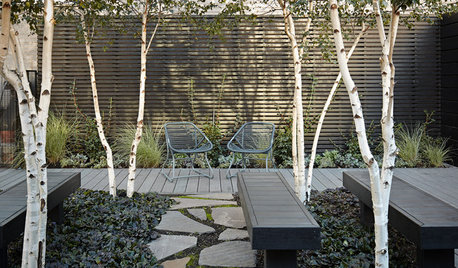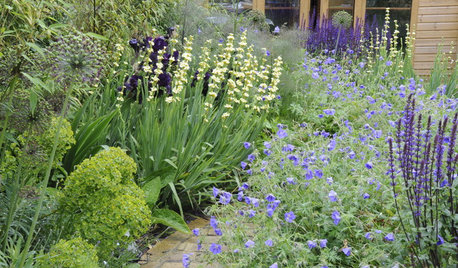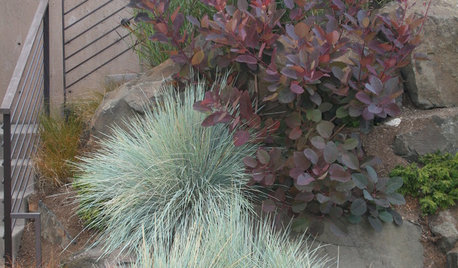Auger used to plant trees
Professionally speaking, I am a long-term member of a Forestry Dept. that has been very progressive in terms of following and adapting modern, research-based methodology. As such, we long ago abandoned the use of powered augers in preparing holes for tree planting. It never was a big part of our program anyway, but when we learned of the pitfalls-pun intended-of using this type of equipt. in our clay-based soils, all use stopped. Those problems are: In clay, the sides of the hole can become "glazed" such that, upon drying out later, they can act like a brick wall inhibiting roots from advancing beyond the small area of loose soil that had been backfilled. They also tend to create holes that are far too deep. Sure, material can be placed back into the hole and then stomped down, but it's hard to know you've actually compacted it enough to prevent later settling. And additionally, the holes so produced are very vertical. There is no "breakout zone" whatsoever in an auger-dug hole.
We have at our disposal a stump grinder and for decades, we've used this machine to prepare perfect, shallow, and tapered planting "beds" in our street and park planting programs.
Another part of my job wherein most of my efforts are directed these days is in our Stormwater utility. Most of the planting work that gets done here is not in-house. Native landscaping contractors are usually the ones on hand to do this tree planting. And every one of them wants to use an auger to plant. I'm having a hard time dealing with this because in their world, this is just what you do, whereas in my world, augers play no role in tree planting.
So I'll throw it out here: Those of you in more of a professional capacity-what do you think about augers/tree planting? I will concede at the outset that in very sandy ground, it probably does no harm to use these things. But where we're located, it's clay loam with heavy red clay subsoil in most instances. This past year's drought notwithstanding, soils are usually moist.
I've written specs to try to achieve a compromise, mentioning that the top of the hole be manually tapered outwards, that the holes not be dug half way to China, and that if wet, the sides be roughed up manually, etc. Still, I wish these things would just go away. There's a reason why utility crews use them to place telephone/electrical poles in the ground!
+oM
Comments (18)
hortster
11 years agolast modified: 9 years agoWe, too have heavy clay and it does glaze, especially if augered on the dry side. The only way a contractor could effectively use an auger would be to make the hole deliberately narrower and shallower than the ball, finishing the depth by hand and also expanding the augered hole to the correct size by hand to remove the glazed sides. I guess that is what you mean by "mentioning that the top of the hole be manually tapered outwards." But you know that some holes are going to get overaugered and the chance for sinkage.
The bottom line, though, is that contractors are relying on machinery that reduces labor (and therefore cost), so it is unlikely that the machines can be eliminated. So, would that unhappy fact make you in Stormwater spend the money on additonal inspectors? Or just spread what you have thinner?
Sadly, trees that are planted improperly with an auger usually live until the guarantee period expires.
hortster
wisconsitom
Original Author11 years agolast modified: 9 years agoThanks Horst. For brevity's sake, I haven't really gone into all of what this entails. For all intents and purposes, I am the inspector on these jobs. The situation I'm running into is that for these contractors, this is tending to be the very first time they ever considered that "the way they've always done it" might not be a good way. Whereas on the forestry side, we were well past all this almost thirty years ago! That's the kind of cognitive dissonance I'm hitting, now that my job focus has been adjusted. I have complete freedom to write the specs. I'm just leery of taking things into territory that almost nobody seems equipped to enter. We still want to have these things happen.
One promising area is that we can do some projects' tree component in-house. Then everything is great. But others are bid out as whole packages. There's really no way to throw our guys into that mix. I'm half tempted to just take this thing where I want to-insisting on proper, research-based work. But only half tempted. It's not the only battle going on!
+oM
Related Professionals
South Orange Landscape Architects & Landscape Designers · Caldwell Landscape Contractors · Conroe Landscape Contractors · Damascus Landscape Contractors · Maywood Landscape Contractors · Paterson Landscape Contractors · New Carrollton Landscape Contractors · Silver Firs Landscape Contractors · Maplewood Landscape Contractors · Shenandoah Landscape Contractors · Point Loma San Diego Siding & Exteriors · Green Bay Decks, Patios & Outdoor Enclosures · Hampton Bays Decks, Patios & Outdoor Enclosures · Oak Ridge Decks, Patios & Outdoor Enclosures · Portland Decks, Patios & Outdoor Enclosuresstrobiculate
11 years agolast modified: 9 years agoproper, research based? that's a murky area if ever there was one. there's not a single report that cannot be refuted with another. i get about fifteen various publications, and i can tell you this...if you were a contractor, you'd ignore the research as well.
we currently do have a divide, enabled by the information age. i worked for over fifteen years in retail nurseries, and i loved it, and i was good at it...now, i'd rather have acid dripped on private parts than do that kind of work.
i currently do residential maintenance, design/build/install for a select group of clients, and occassional consult...after word of mouth, that's how i drum up new business.
ask me how to lay a patio, that's a straightforward answer.
ask me how to plant a tree, i sense a minefield.
think maybe we need to clear a few things up? or at least have not quite so many voices claiming to be expert?
if you have the ability to write or rewrite the specs, use it. if people stop bidding, you may need to reconsider. if the bids start coming in so high there is no way they'll be accepted, maybe reconsider.
first question that comes to my mind, what is the research you base things on. i just need the authors, not the books or papers they wrote...i probably have the writings, just want to know what you're referencing.
second, the world of nurseries and landscapers is rather conservative. change happens slowly, because too many things that were supposed to radically alter the cosmos have proven to be hot air. and i hate to say it, but research ideas are the worst. i have seen some pretty strange ideas passed off as the latest research, only to be refuted a year or so later. and i have seen some pretty compelling research ignored because it was not in agreement with the current general consensus.
but all of that is background noise.
write the specs, and see what kind of response you get. that will tell more powerfully than anything if you are on to something or not.
gardener365
11 years agolast modified: 9 years agoIf you're in the Christmas tree growing business than an auger is the go to norm. Otherwise, there is no better way to plant something woody other than taking time to inspect the entire root-system, build up a mound inside the planting hole, loosen the sides of the planting hole if clay with a pick axe or slamming a shovel into the sides, and then carefully spread the root system over the mound keeping and manipulating roots to extend straight and down over the mound & clipping off any "J" roots above the "J-hook" so they have a chance to grow straight once again.
When I plant a tree/shrub, I take all the time necessary to insure that every move I do is thoughtful and tactful. I leave nothing to question.
With Christmas tree growers, this isn't the case. They will lose trees, however, the more they can get planted in a 'chain effort' - if that makes sense, i.e. group of people coming along together to do various steps in the planting process, the more trees they will have and less wages they will pay to get the job completed. Surely their trees will/would fail at some point in time, but I'm sure they will grow to salable size before death of a tree occurs.
Dax
slimwhitman
11 years agolast modified: 9 years agoThis is a great topic. I hope to see more smart replies to the auger question. As a landscape architect, I see this method used all the time, but have not worried about it. Maybe I should? The other question I always hear multiple answers to is the wire basket. I have seen many trees die because the rootball fell apart when the basket was removed. Are you suggesting that we need to remove that wire basket, no questions asked?
wisconsitom
Original Author11 years agolast modified: 9 years agoWhile we plant few B&B trees these days, when we did/do, we always take all the garbage off the ball. Just get it set in the hole and cut the twine, cut the wire with a small bolt cutter. Takes less than a minute. No, we did not have any casualties as a result of doing this.
+oM
strobiculate
11 years agolast modified: 9 years agoyou ask a question that is a mixed bag of squirrels at the best of times, and then act aghast when not everyone agrees with you completely? i guess i misunderstand the nature of open and honest discussion.
my honest answer is, if it bothers you and you have the ability, write the specs any way you desire. if you don't get people responding to the bid request, you have your answer. or if the only people who do respond are the morons you refuse to do business with, you have another answer. or if you get responses from the people in your town you trust and respect in terms of the work they do, you have yet another answer. no matter what, you have your answer. It remains to be seen if it is one you like.
when it comes to being progressive...at best, a subjective delineation. so anyone who has a different opinion is not? how do we determine what is or is not progressive? and if you are so progressive, i assume that means you have abandoned the barbaric and cannabalistic practice of awarding contracts based on lowest bid?
when it comes to digging a hole four feet deep to plant a root ball maybe what, 12" deep, what do you expect me to say, that no one who has ever planted a tree has ever done anything stupid? Or is it your contention that this is standard practice? I have no doubt it is done...boys and toys...but are you telling me it is done once in a while, or nearly every time?
In all probability, I have not seen the same presentations you are referencing, because I have never lived within 500 miles of you. But I probably have seen similar.
Past of my issue is a question of context. It's easy to determine why a tree died by digging it up and seeing what it has to say. I do this all the time. But what is the percentage of occurrence? And can the problems demonstrated be positively linked to the issues you describe? In easily a third of cases I see where roots have failed to grow outside the original rootball, the tree had no chance to grow because of ground conditions at the site. And I see more cases where the tree died because people followed planting instructions they found online rather than what the nursery provided. Most common reason I see trees die? Irrigation systems and sod.
But back to context. If you are only exhuming failed plantings, you have a skewed data set. Yes, it may be a data set you want to examine more closely, and not saying there is no value in learning what you can...but I am saying it is not an entire picture. And unless you also examine plantings that have not failed, you don't know if you just have the end of the curve that never had a chance. And then there are site conditions. If a tree is planted in subsoil muck because that is where the marker was stuck and so that is where the tree is being planted, mm*t, are you going to tell me later that it is the fault of planting methodologies?
One of the things I do is try to determine why trees have failed. In easily half of all cases of trees planted in the same time frame you reference, I find site conditions that are more problematic than planting methodologies. The poor things never had a chance. So it's the fault of the people who grew them or who planted them. It has to be.
In my lifetime, the accepted way of how to plant a tree has changed. And the way I learned was vastly different than what my grandfather learned. The one thing I know is there is a massive disconnect between different parties at this table. Nurserymen, landscapers, arborists, university research staff and professors, and city foresters...all have different stakes in this. Few of whom talk except across rather narrowly defined channels. All of whom really just care about it not being their fault, whatever it is. Or they want to be able to impress how much they care. By laying blame elsewhere. Don't take this too personal. This is my honest opinion, perhaps valid for no one else in the cosmos...but since you're not me, you don't have to care what I think.
For years, I have seen this debate emerge and never have I seen it come together. Each set of stakeholders has their own turf. Are you saying you care more than I do because you want every tree to succeed and I see a world in which a certain number are going to die, no matter what? Or are you a better steward of municipal funds because you want to ensure the best possible result at the lowest possible cost?
Or am I somehow more evil because I have certain interests to protect and don't want to expose myself to the complete range of human stupidity and manipulation in the doing?Nothing is ever simple, and the only constant is change. This I know, and can positively affirm. The rest? It's all subject to change.
ken_adrian Adrian MI cold Z5
11 years agolast modified: 9 years ago+om
i would like to commend you...
for finally finding a topic upon which i have no experience ...
and get this..
NO OPINION .. lol..
as you were ....
ken
wisconsitom
Original Author11 years agolast modified: 9 years agoStrob, context is indeed the issue here. It seems you think I asked a question. I actually requested that a discussion about this issue take place. It further seems that you think my subsequent set of actions depend solely and entirely on what I read in this thread! Crazy stuff. It happens that I find enough of value in this forum to participate, and that participation extends to posing areas of discussion just to see what can develop. If I depended on this info for a satisfactory outcome in my professional dealings, I'd be in some considerable trouble!
Presumption is the big pitfall to such forums. Someone sees a little toehold on what someone else posts and uses it to lambast the original poster for their incomplete understanding of the issues involved. I've probably done this too. I'd like to assure you that the answers to all the questions in your latest post could be summed up with the word no. No, I don't nor would I ever expect all trees that are planted to survive. No, I would never disregard site conditions in assessing this or that outcome. No, no, no.
You're right about that one thing-we've probably never done our work within 500 miles of one another. I wish then that you would be capable of reaching the next conclusion-it is extremely unlikely that you have gained, from the few words I've posted above, a thorough understanding of where I'm at with such matters. How could it be so?
+oM
hortster
11 years agolast modified: 9 years agoThis thread stirs up a bunch of thoughts. Getting back to the auger...
Yes, each party in this matter has a different perspective, but the bottom line is, indeed, the bottom line. We all know that most every spec that is written (and is actually followed) adds more labor time.
What if it was specified that there be a three-year guarantee period with no charge replacements by the contractor? And throw in three years of maintenance by that contractor as part of the package. And specify a planting technique that assured that the sides of the planting pit were not glazed and that the ball wouldn't be set to deeply.
Now, throw that puppy out for bids. The question becomes whether or not the higher labor costs that contractors perceive they need to charge will provide for a higher initial take of the trees that actually costs less in the long run as far as tree health and arbor work goes. Or, letting them do it "the way they've always done it" and be ready to accept initial losses for a lower cost. Oh, and then there's the expense down the road to remove larger trees that make it for a while but finally have choked themselves off.
Can there really be a firm answer? For me, the only ideal planting scenerio that I am sure about has happened in my own yard! We may know the best ways (OK, strob, perceived at this time to be the best) to plant and maintain but it all boils down to money and control, both of which are usually short.
hortster
Embothrium
11 years agolast modified: 9 years agoAn effectively non-variable, non-debatable combination that should be the bottom line here is that roots want to grow out mostly sideways in aerated soil mostly near the surface. In the case of larger specimens, Carl E Whitcomb was quite some years ago advocating digging planting holes wih backholes (instead of tree spades) and filling them back in with shovels. Using an auger for smaller stock would produce similar effects to using a tree spade.
wisconsitom
Original Author11 years agolast modified: 9 years agoIn terms of what I've seen, the only time a hole is dug by tree spade is when the tree to be planted there is also being spade-dug. In the scenario I'm outlining here, that is seldom the case. We did in fact move some larger trees by spade a few years ago and in that case, loosening of the perimeter of the newly-set tree was done. In any case, survival was 100%.
The issue here is that of small planting stock, but lots of it. Contractors want to use power augers. It is apparent that nobody prior to myself has ever raised an objection. I have all the means at my disposal to deal with that fact. I am hoping here to see other opinions-not about how I should proceed in my dealings with these contractors-but about what others' perceptions are regarding the use of this tool in tree planting.
About ten years ago, I planted two swamp white oaks in my parents' then-new yard. Well, it turned out that when the lot next door was sold (By my dad), one of these oaks was actually on the wrong side of that line. I didn't have the opportunity to deal with it but some guy with a backhoe did! Must have been a pretty good operator-the trunk didn't get dinged up and the tree was set at close to proper depth. The tree is actually gaining height faster than its unmoved mate.
We also sometimes have contractors install numerous herbaceous plants. In the bigger jobs, very small augers are used. I really have no particular objection to this. It may well be that all the same factors come into play for these grasses, forbs, and sedges, but one-year warranty survival seems more meaningful in this domain. With woody plants, as most of us know, mere survival for a year or three tells us little about long-term development of the plant(s).
+oM
arktrees
11 years agolast modified: 9 years agoI am not at all a professional in the this field. I do have s good of education related to much of this, but take whatever I say on the subject with a grain of salt, and do not take it personally as it is not intented as such.
IMHO, in the larger picture is that we have competing interest. The contractor needs to be able to do the job as efficiently and as quickly as possible. While the entity needs the lowest cost possible AND a VERY satisfactory result. Somehow both need to be accomplished. Specs are certainly warranted, in the fact that they are needed to remove guess work, and harmful short cuts that can occur under some circumstances, or simple lack of understanding. So how best would this be accomplished. Seems to me that a modification of the auger and the method it is used would be the simplest and most effective. Perhaps a arguer in a wide conical shape instead of a cylinder, with specifications as to how deep it can go. This could then be followed up with using a simple rake on the sides of the resulting hole that would break up the glazed surface, or some other tool to break that surface as quickly and effectively as possible. Perhaps the cutting surface of the auger could be modified as well to yield better results?
Just a couple of thoughts.
Arktrees
hortster
11 years agolast modified: 9 years agoArktrees, such an auger shape exists. But the problem remains - it is going to take not a rake but an additional machine of some kind to deglaze the sides in when heavy clay. Maybe something on the order of +oM's stump grinder on a smaller scale.
hortster
Here is a link that might be useful: Conical auger hole
arktrees
11 years agolast modified: 9 years agohorster,
I understand that further processing would be needed. The basica ideal I was trying to get at was modifying the tools to give a better result. IN your link, I like the stair stepped sides, but as you said, something still needs to be done for the glazing. What that is, I can't say. This is where strobiculate might be able to add something useful.Arktrees
strobiculate
11 years agolast modified: 9 years agotom, i've twice stated my honest gut opinion. no offense meant. if you want to tell me i am clueless, i really can't tell you how much to heart i take it.
i've worked in pa,nd, mn, in, and ny. in each place, when i get involved in discussions of use of equipment in planting, people i talk to are at least aware of potential issues. so my conclusion is that people who live in a state where cheese is an acceptable form of headgear are just slower on the uptake?
in twenty years looking for ways of doing things faster, easier, more efficiently, with the best possible outcome, the only thing i can say for certain is there is no piece of equipment that will work in all soil types under all possible moisture conditions.
i've seen augers that are tapered, stepped, have little bits attached to the sides to roughen up the hole...and under certain conditions they all work, and under certain conditions they all fail.
personally, i like to use a backhoe. or at least, i did, until someone had to point out whitcomb likes that technique...is it possible.to claim ignorance? but that's usually for the big trees. for smaller trees, usually 2" to 3", i tend to use an auger smaller than ball size and finish with a shovel.
and i'm pretty sure whatever i have to say is absolutely not worth the saying. so if.you will excuse me, there's a.banana calling my name.
wisconsitom
Original Author11 years agolast modified: 9 years agoAh, you're back. You know, it only just occurred to me that you took my initial query as a personal attack. Must be the cheese hat. Ah, nothing like throwing a good stereotype or two into a conversation! There lies the path to truth. Now try to imagine this: There are people who both live in this state and who are mildly embarrassed by the apparel choices of some of our fellow residents. Shocking, isn't it?
But I'm not like that. I even follow the research, er, bag of squirrels, of a guy down in Illinois, goes by the name of Gary Watson. He's done as much as anyone in terms of trying to understand tree root/rooting environment interface. And those lazy good-for-nothing bums in Florida have this Ed Gilman guy...seems to have some little interest in what's what with trees.
But you, no, you don't need any of that. So far past it all are you! Carry on. If you think a perfect stranger started a thread on an online forum to make you "look clueless", I'm afraid there's bigger issues at hand than what technique is or isn't used in tree planting.
+oM



















wisconsitomOriginal Author